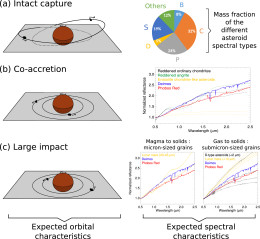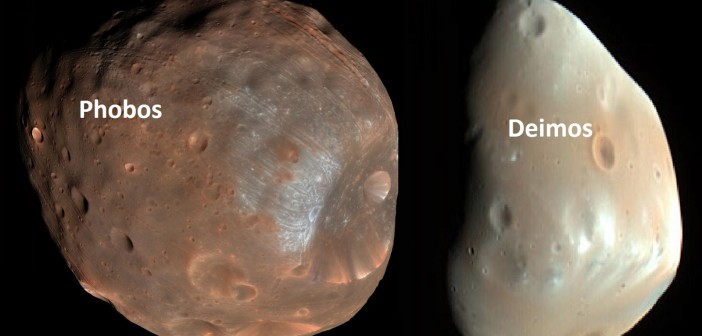A new study examines the possibility that Mars’s two moons formed after a large body slammed into Mars, creating a disk of debris. This scenario might be the key to reconciling the moons’ orbital properties with their compositions.
Conflicting Evidence

The different orbital (left) and spectral (right) characteristics of the Martian moons in the three different formation scenarios. Click for a better look! Phobos and Deimos’s orbital characteristics are best matched by formation around Mars (b and c), and their physical characteristics are best matched by formation in the outer region of an impact-generated accretion disk (rightmost panel of c). [Ronnet et al. 2016]
- Two already-formed, small bodies from the outer main asteroid belt were captured by Mars, intact.
- The bodies formed simultaneously with Mars, by accretion from the same materials.
- A large impact on Mars created an accretion disk of material from which the two bodies formed.
Our observations of the Martian moons, unfortunately, provide conflicting evidence about which of these scenarios is correct. The physical properties of the moons — low albedos, low densities — are consistent with those of asteroids in our solar system, and are not consistent with Mars’s properties, suggesting that the co-accretion scenario is unlikely. On the other hand, the moons’ orbital properties — low inclination, low eccentricity, prograde orbits — are consistent with bodies that formed around Mars rather than being captured.
In a recent study, a team of scientists led by Thomas Ronnet and Pierre Vernazza (Aix-Marseille University, Laboratory of Astrophysics of Marseille) has attempted to reconcile these conflicting observations by focusing on the third option.
Moons After a Large Impact
In the third scenario, an impactor of perhaps a few percent of Mars’s mass smashed into Mars, forming a debris disk of hot material that encircled Mars. Perturbations in the disk then led to the formation of large clumps, which eventually agglomerated to form Phobos and Deimos.

The authors find that Phobos and Deimos most likely formed in the outer regions of the accretion disk that was created by a large impact with Mars. [Adapted from Ronnet et al. 2016]
Phobos and Deimos could have formed, however, in the very outer part of an impact-generated accretion disk, where the hot gas condensed directly into small solid grains instead of passing through the magma phase. Accretion of such tiny grains would naturally explain the similarity in physical properties we observe between Mars’s moons and some main-belt asteroids — and yet this picture is also consistent with the moons’ current orbital parameters.
The authors argue that the formation of the Martian moons from the outer regions of an impact-generated accretion disk is therefore a plausible scenario, neatly reconciling the observed physical properties of Phobos and Diemos with their orbital properties.
Citation
T. Ronnet et al 2016 ApJ 828 109. doi:10.3847/0004-637X/828/2/109

1 Comment
Pingback: The Moon’s Origin Story Is in Crisis – The Atlantic – Slinking Toward Retirement